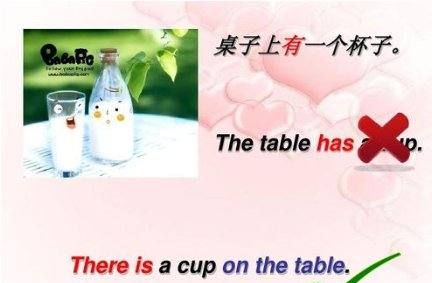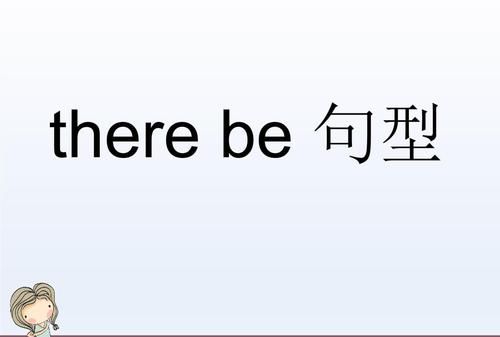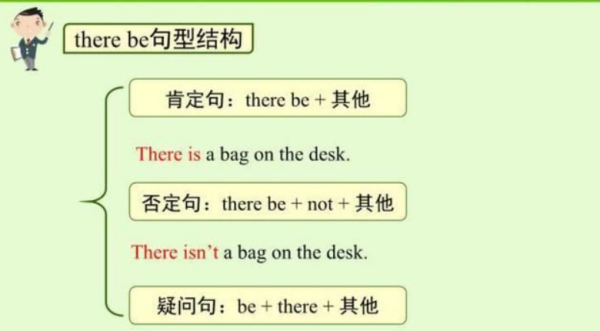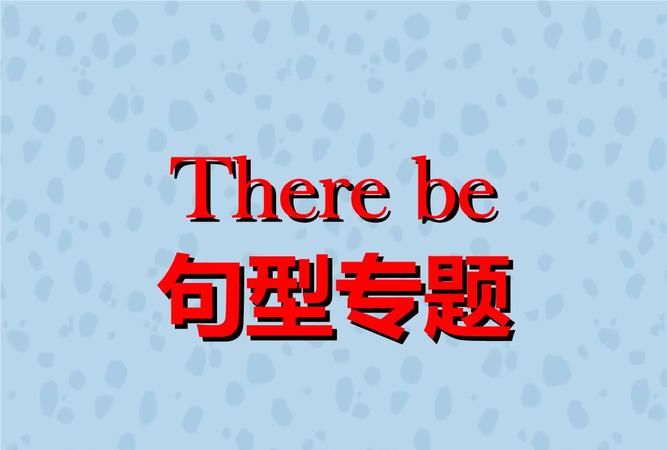本文目录
there be句型是什么意思
There be 句型是英语中常用句型, 意思是“有”,表示“人或事物的存在”或“某地有某物”。There在此结构中是引导词,已经没有副词“那里”的含义。
There be 句型的构成形式一般为“There is/are + 某物/人 +某地/时”,表示某地/时有某物/人, be可以是表示存在的动词,例如lie,stand,appear to be。
There be 后面的名词是句子的主语,属倒装结构。疑问句形式是将be或will/have/can/must等助动词、情态动词提至there之前。
否定形式则直接在be或助动词、情态动词后加not,因此要表达“某个地方或某个时间存在什么事物或人”的时候常用“There be + 名词+ 地点(时间)这一句型。

扩展资料
There be句型的特殊疑问句式
1、针对数量提问
一般来说,针对数量提问的特殊疑问句,我们用How many / much (取决于名词是可数还是不可数)。因此,当表示“在什么地方有多少东西”的时候,我们就把how many/much跟there be结合起来。
句式为:How many / much … are/is there…?
例如:There are five sheep on the farm. (对划线部分提问)
2、针对主语提问
对there be句型的主语提问的时候,如果主语是人,用who引导;如果主语是物,则用what引导。
例如:There are five sheep on the farm. (对划线部分提问)
3、针对地点状语提问
There be句型中,如果是针对地点进行提问,则用where。
例如:There are five sheep on the farm. (对划线部分提问)
对there be句型中的主语提问常用什么
用what代替某物,放在句首,后面用疑问句语序即可。
what is /are there 加其他(地点状语)?

there be句型对数量提问怎么提问
1、对主语提问:当主语是人时,用 “Who’s + 介词短语?”;当主语是物时,用 “What’s + 介词短语?”。其中there在口语中常常省略。注意:无论原句的主语是单数还是复数,对其提问时一般都用be的单数形式(回答时却要根据实际情况来决定)。如:
There is a bird in the tree. →What’s in the tree?
There are some bikes over there. →What’s over there?
There is a little girl in the room. →Who is in the room?
2、对地点状语提问:用 “Where is are + 主语?”表示(注意其答语变化):例如:
There is a computer in my office.
→ Where is the computer? ----It’s in my office.
There are four children in the classroom.
→Where are the four children?—They’ re in the classroom.
3、 对数量提问:一般有两种提问方式:
如果主语是可数名词,无论是单数还是复数,都用“How many +可数名词复数+ are there + 介词短语?”表示:
There are twelve months in a year.
→How many months are there in a year?
There is only one book in my bag.
→ How many books are there in your bag?
There is a cat in the box.
→ How many cats are there in the box?
如果主语是不可数名词,则用“ How much + 不可数名词 + is there + 介词短语?”表示:
There is some money in my purse. How much money is there in
your purse?
反意疑问句:There be或There加其它动词,其反意疑问句一律用…there?例如:
There is a beautiful girl in the garden, isn’t there?
There used to be no school here, used there did there?

扩展资料:
注意事项:
1、There be句型中be动词的形式要和其后的主语在人称和数上保持一致。
如果句子的主语是单数的可数名词,或是不可数名词,be动词用“is”“was”。例如:
There is a basketball in the box.
There is a little milk in the glass.
如果句子的主语是复数名词,be动词就用“are” “were”。例如:
There are many birds in the tree. There were many people in the street yesterday.
如果有两个或两个以上的名词作主语,be动词要和最靠近它的那个主语在数上保持一致,也就是我们常说的 “就近原则”。例如:
There is an orange and some bananas in the basket.
There are some bananas and an orange in the basket.
2、There与be中间可插入一些表推测的情态动词、表时态的短语和一些动词短语 (如和将来时be going to will、现在完成时 havehas + pp、used to结构等连用,注意其构成形式,这一内容在我们日常练习中经常出现错误,是一难点,也是历年中考试题中的一个考点.)。例如:
There must be a pen in the box.
There happened to be some money in my pocket.
There is going to be a meeting tonight.
There has been a big tree on the top of the hill.
There used to be a church across from the bank.
3、There be句型和havehas的区别:
There be句型表示 “存在有”, havehas表示 “拥有” “所有”,两者不能同时使用.例如:
桌子上有三本书. There are three books on the desk.
我有三本书. I have three books.
4、 There be + 主语 + doing +介词短语. 例如:
There is a truck collecting rubish outside.
There is a wallet lying on the ground.
举例
There are two dogs in the garden.
There weren't any people in the park yesterday.
There won't be another football match next Sunday.
There have been some changes since you left last week. There is a book on the desk.
There can't be anything new.
Must there be an indefinite article here?
Is there going to be a post office in the village?
There is a great Italian deli across the street.
There are some students in the dormitory.
参考资料来源:百度百科-there be 句型
there be句型的问句怎么写
一、构成:There be ...句型表示的是 “某处有(存在)某人或某物”,其结构为There be(is,are,was, were )+名词+地点状语。例如:There are fifty-two students in our class.
There was an old house by the river five years ago.
二、各种句式:
否定句:
There be句型否定句式的构成和含有be动词的其它句型一样,在be后加上“not”。也可用“no”来表示。即:no + n.(名词)= not a\an\any + n.(名词)。注意:no + n.(可数名词单数)= not a\an + n.(可数名词单数);no + n.(可数名词复数)= not any + n.(可数名词复数);no + n.(不可数名词)= not any + n.(不可数名词)。
一般疑问句:
There be结构的一般疑问句变化只需把be动词移到句首,再在句尾加上问号即可。例如:
There is some money in her handbag.
→ Is there any money in her handbag? (疑问句和否定句中,some改为any, something改为anything.)
There is something new in today’s newspaper.
→There isn’t anything new in today’s newspaper.
→Is there anything new in today’s newspaper?
特殊疑问句:
There be句型的特殊疑问句有以下三种形式:
① 对主语提问:当主语是人时,用 “Who’s + 介词短语?”;当主语是物时,用 “What’s + 介词短语?”。其中there在口语中常常省略。注意:无论原句的主语是单数还是复数,对其提问时一般都用be的单数形式(回答时却要根据实际情况来决定)。如:
There is a bird in the tree. →What’s in the tree?
There are some bikes over there. →What’s over there?
There is a little girl in the room. →Who is in the room?
② 对地点状语提问:用 “Where is \ are + 主语?”表示(注意其答语变化):例如:
There is a computer in my office.
→ Where is the computer? ----It’s in my office.
There are four children in the classroom.
→Where are the four children?—They’ re in the classroom.
③ 对数量提问:一般有两种提问方式:
如果主语是可数名词,无论是单数还是复数,都用“How many +可数名词复数 + are there + 介词短语?”表示:
There are twelve months in a year.
→How many months are there in a year?
There is only one book in my bag.
→ How many books are there in your bag?
There is a cat in the box.
→ How many cats are there in the box?
如果主语是不可数名词,则用“ How much + 不可数名词 + is there + 介词短语?”表示:
There is some money in my purse. How much money is there in
your purse?
反意疑问句:There be或There加其它动词,其反意疑问句一律用…there? 例如:
There is a beautiful girl in the garden, isn’t there?
There used to be no school here, used there \did there?
三、注意事项:
1. There be句型中be动词的形式要和其后的主语在人称和数上保持一致。
如果句子的主语是单数的可数名词,或是不可数名词,be动词用“is”“was”。例如:
There is a basketball in the box.
There is a little milk in the glass.
如果句子的主语是复数名词,be动词就用“are” “were”。例如:
There are many birds in the tree.
There were many people in the street yesterday.
如果有两个或两个以上的名词作主语,be动词要和最靠近它的那个主语在数上保持一致,也就是我们常说的 “就近原则”。例如:
There is an orange and some bananas in the basket.
There are some bananas and an orange in the basket.
2. There与be中间可插入一些表推测的情态动词、表时态的短语和一些动词短语 (如和将来时be going to\ will、现在完成时 have\has + pp. 、used to结构等连用,注意其构成形式,这一内容在我们日常练习中经常出现错误,是一难点,也是历年中考试题中的一个考点.)。例如:
There must be a pen in the box.
There happened to be some money in my pocket.
There is going to be a meeting tonight.
There has been a big tree on the top of the hill.
There used to be a church across from the bank.
3. There be句型和have\has的区别:
There be句型表示 “存在有”, have\has表示 “拥有” “所有”,两者不能同时使用.例如:
桌子上有三本书. There are three books on the desk.
我有三本书. I have three books.
4. There be + 主语 + doing +介词短语. 例如:
There is a truck collecting rubish outside.
There is a wallet lying on the ground.

以上就是关于therebe句型对物提问 ,therebe特殊疑问句what的全部内容,以及therebe句型对物提问 的相关内容,希望能够帮到您。
